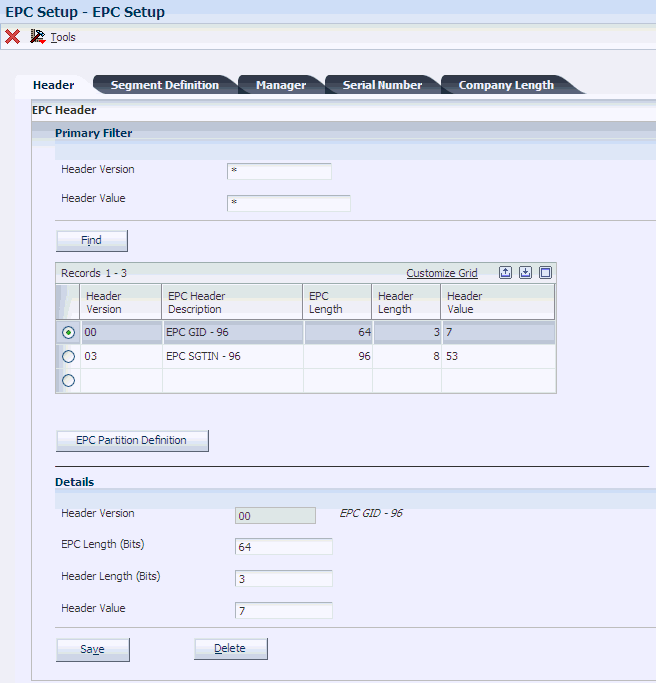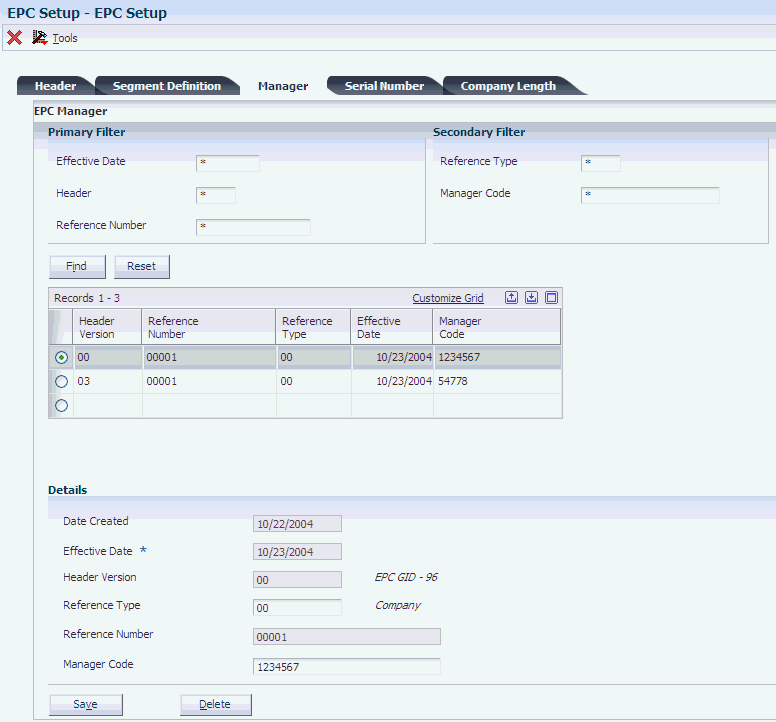4 Working with Radio Frequency Identification (RFID) Processing
This chapter contains the following topics:
4.1 Understanding the GTIN
The GTIN enables you to identify items in the standard EAN.UCC System. The GTIN is a product number that uniquely identifies the item, level of packaging, and manufacturer. Level of packaging refers to a standard quantity of units of the item which the unit of measure represents.
The system uses the RFID user-defined code (UDC) value for Number Type (46R/NT) for setting up the GTIN. This value is hard-coded. However, you can set up different unique product numbering types as needed in this UDC such as National Drug Code (NDC).
4.2 Understanding EPCs
The EPC is a simple, compact "license plate" that uniquely identifies objects (items, cases, pallets, locations, and so on) in the supply chain. The EPC is built around a basic hierarchical idea that expresses a wide variety of different, existing numbering systems, like the EAN.UCC System Keys, UID, VIN, and other numbering systems. Like many current numbering schemes used in commerce, the EPC is divided into numbers that identify the manufacturer and product type. But, the EPC uses an extra set of digits, a serial number, to identify unique items. The EPC is the key to the information about the product it identifies that exists in the EPCglobal Network. When you create EPCs, ensure that you are complying to the standards for EPCglobal. The example in the table describes some common segments which relate to the version of the EPC Tag Data Standards called General Identifier (GID-96):
- Header
-
The header segment provides the version number of the standard and identifies the length, type, and structure of the EPC. You must set up the header segment before setting up the segment definitions, manager, and serial number. Segment lengths combined, including header length, must match the overall length in the header definition.
- General Manager
-
The general manager segment, also called the Domain, represents the manufacturer or brand owner manager number.
- Object Class
-
The object class segment represents the manufacturer's stock keeping units (SKU), to identify the item.
- Serial Number
-
The serial number is a unique number of an item within an object class of the EPC.
The length of each segment is defined by how many bits are required to fill that segment. This example describes the bit lengths per segment of an EPC:
| Segment | Header | Manager | Class | Instance |
|---|---|---|---|---|
| 96-bit | 8 | 28 | 24 | 36 |
This example is a typical EPC:
| Header | Manager | Class | Instance |
|---|---|---|---|
| 01 | 0000A89 | 00016F | 000169DC0 |
The system represents and stores the header value, manager code, and EPC serial number in decimal format. Lengths are represented in bits. The system converts the decimal values (base 10) to bits (base 2) and generates and stores the EPC number in hexadecimal (base 16) format.
You set up the EPC for GID-96 based on the values for customer ship to/sold to and carton type. The system stores the EPC number in the Carton Serial Number field in the Carton Detail Information - (F4620).
You can use the Label Serial Numbers (Preference Type 38) preference in combination with the Carton Label (Preference Type 39) preference and the Carton Reorganization (P4620) processing options to specify how the system processes EPCs. If you do not specify a preference type and indicate to use the preference, the system uses the value established in the Serial Number Creation processing option on the Serial Number tab in the processing option for Carton Reorganization (P4620).
You can use an EPC number in addition to a UCC-128 or label next number.
4.3 Understanding EPC Numbers for Outbound Shipments
You can generate an outbound EPC from these applications:
4.3.1 Carton Reorganization (P4620)
You can generate EPC numbers when creating carton detail from cartons and item quantity on Carton Reorganization (P4620). The system creates EPC numbers at the carton level. For example, the EPC may be created for cases of a certain type for the specified customer on the shipment.
After you create or reorganize cartons in a shipment, you also might want to review carton detail information. The Carton Detail Inquiry program (P4621) enables you to review this type of carton detail information:
-
Carton identification information.
-
Item information.
-
EPC.
-
Weight and dimension information.
-
Related sales order information.
-
UCC 128 information.
4.3.2 Standard Pack Carton Recommendations (P4615)
You can automatically assign EPC numbers for outbound shipping cartons when creating carton detail from carton recommendations.
4.3.3 Inbound Labels
The third-party can send data generated from label processing back to the JD Edwards EnterpriseOne system. This data can include the EPC, but if it does not include EPC (or carton serial number) information, you can generate that information as a step in this process. The system stores the label data in the Carton Detail Information table (F4620). This table must be updated with accurate information from the physical shipment because the system uses this information to create packaging information on the ASN and the Bill of Lading.
You generate outbound label data from system tables to a third-party for formatting and printing. The outbound label information includes the Ship To address, EDI data, and demand scheduling data, such as the supplier or plant code (Party Type 1 and 2), and can include the EPC.
4.3.4 Create Task and Trip (R46471)
You can generate EPC numbers when you create task and trips for suggestions. The system can create the EPC number at the carton level when you create carton detail.
4.3.5 Warehouse Movement Confirmations (P4617)
You can generate EPC numbers during pick confirmation over confirmed item quantity on pick suggestions. The system can create the EPC number at the carton level when you create or update carton detail.
4.3.6 ASN Packaging Revisions (P470371)
You can generate EPC numbers when running this program.
4.4 Understanding EPC Inbound Processing
The system processes RFID information during the inbound ASN (Advance Ship Notice) process. The system can carry the EPC number inbound through to the receipt file and it displays on some receipt routing forms. Carton Serial Number field (EPC) exists in these tables:
-
EDI Shipping Notice Detail – Inbound (F47032)
-
EDI Receiving Advice Detail – Inbound (F47072)
-
Purchase Order Receiver (F43121)
These programs also process the EPC:
-
Status Inquiry Revisions (P47030). You can edit this field on the Inbound EDI Shipping Detail Revisions form.
-
Receipt Routing Movements and Disposition. On the Receipt Routing Movement form, the EPC exists as a filter field in the header and detail area.
Note:
The system does not display the EPC field on the Receipt Routing Movement form if you enter 1 in the Show Shipment and Pack Information processing option on the Display tab. -
Routing Ledger Inquiry (P43252). On the Work With Receipt Routing Ledger (W43252D) form the EPC Number field exists as a header filter field and for QBE functionality.
-
EDI Shipping Notice Edit/Create (R47031). The system displays the EPC information on this report.
-
Inbound Receiving Advice Edit/Update (R47071). The system creates license plate data from inbound advance ship notices (ASN) for on-hand quantities received.
Note:
You can process only one entire inbound ASN batch of records at a time. -
License Plate Management (46L). You can generate EPC numbers for items when processing license plate information.
4.5 Prerequisites
Before you complete the tasks in this section:
-
Set up the RFID Outbound UDC for the EPC Header (46R/HD).
-
If you are not using the Label Serial Numbers (Preference Type 38), set up the method for generating EPC numbers. To do so, enter a value in the Serial Number Creation Process Value processing option on the Serial Number tab in the Carton Reorganization (P4620) application.
Note:
If you are using the Label Serial Numbers (Preference Type 38) preference, you must set up the processing options for Carton Reorganization to specify that you are using the preference. -
Create a transportation shipment.
4.6 Setting Up RFID Processing Information
This section discusses how to:
-
Set up unique product numbers.
-
Set up EPC header values and segments.
-
Set up EPC partition definition.
-
Generate EPC numbers when creating carton detail.
4.6.1 Forms Used to Process RFID Information
4.6.2 Setting Up Unique Product Numbers
Access the Unique Product Number Setup form.
Figure 4-1 Unique Product Number Setup form

Description of ''Figure 4-1 Unique Product Number Setup form''
- Number Type
-
Enter a UDC 46R/NT. In this case, GTIN. You can enter other types of numbers in this field, such as the National Drug Code (NDC) or EAN-8.
Enter EPCOC to set up the object class code to be used in the manual EPC configuration.
- Item Number
-
Enter the item number.
- Unit of Measure
-
Enter a UDC (00/UM). If you do not enter a value, the item's primary unit of measure is the default value. If the item has a dual unit of measure, and the Picking processing option is set, then the system uses the item's secondary unit of measure as the default value.
- Address Number
-
(Optional) Enter the customer's address book number.
- Unique Product Number
-
Enter the unique product number. This is up to a 30-digit alphanumeric value. The system validates the uniqueness of the product number. If you specify that the number type is GTIN, this value must adhere to the GTIN valid format, and the system validates that the number is 14 decimal digits long and the check digit is correct. If you specify that the number type is EPCOC, the system validates this value in decimal format.
4.6.3 Setting Up EPC Header Values and Segments
This section discusses how to:
-
Set up EPC header.
-
Set up EPC segment definition.
-
Set up EPC manager.
-
Set up EPC serial number.
-
Set up EPC company length
4.6.3.1 Setting Up EPC Header
Access the EPC Setup form, and then select the Header tab.
- Header Version
-
Enter a UDC 46R/HD to specify the EPC version. Use this code to associate the EPC header attributes, such as total EPC length and header value, with an EPC segment definition.
- EPC Length (Bits)
-
Enter the total binary (base 2) length of the EPC. This value represents the entire length, in bits, of the EPC.
- Header Length (Bits)
-
Enter the header binary length of the EPC header segment. This value represents the length, in bits, of the header segment of the EPC.
- Header Value
-
Enter the value of the EPC header. You enter this value in decimal format. The system converts the value into bits when generating EPC numbers. When converted to bits, the length of the value cannot exceed the header length.
4.6.3.2 Setting Up EPC Segment Definition
Access the EPC Setup form, and then select the Segment Definition tab.
Figure 4-3 EPC Setup form — Segment Definition tab
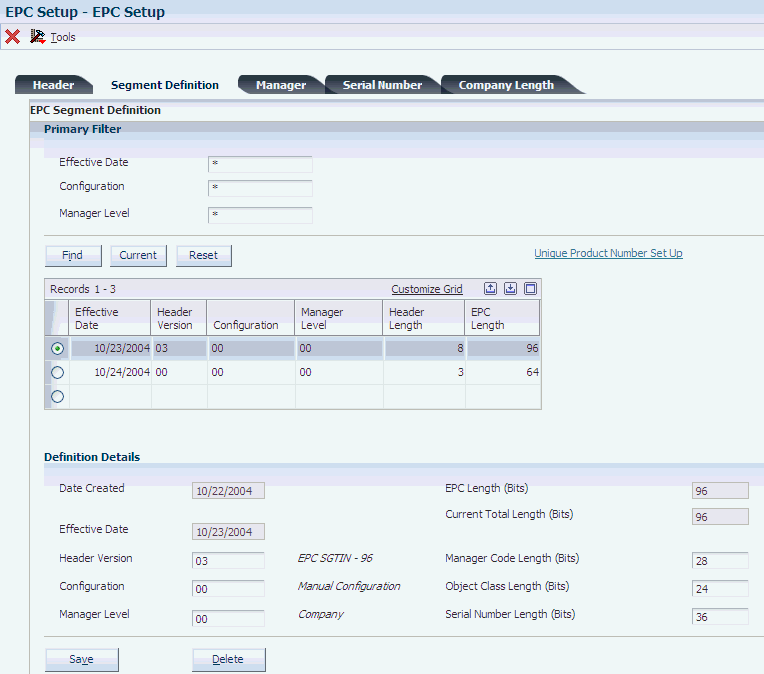
Description of ''Figure 4-3 EPC Setup form — Segment Definition tab''
- Date Created
-
Displays the current date.
- Effective Date
-
Enter the date which this record becomes available for use in EPC number generating transactions.
- Configuration
-
Specify the configuration for the EPC construction. The EPC is a combined value of the header, manager, object class, and serial number.
- Manager Level
-
Specify the level at which the EPC manager value is associated with internal entities. The manager identifies the manufacturer or brand owner, and is assigned by EPCglobal. You can specify to have the manager associated with the company, branch/plant, or customer of the transaction that is generating the EPC number. For GTIN or SSCC, the manager uses defaults to company.
- Current Total Length (Bits)
-
Displays the entire length of the EPC, in binary based on the current segment definition lengths. The system validates the total length against the header definition.
- Manager Code Length (Bits)
-
Enter a value can be between 8 and 64 characters. Manual configuration enables you to populate the length of the EPC manager segment, in bits.
- Object Class Length (Bits)
-
Enter a value can be between 8 and 64 characters. The Manual configuration enables you to populate the length of the EPC Object Class code, in bits.
- Serial Number Length (Bits)
-
Enter the EPC serial number length. The length value can be between 8 and 64.
- Current
-
Click Current to display the currently effective segment definition.
4.6.3.3 Setting Up EPC Manager
Access the EPC Setup form, then select the Manager tab.
- Reference Type
-
Enter a UDC 46R/ML to specify the level at which the EPC managers are associated with internal entities, such as company, branch/plant, or customer.
- Reference Number
-
Enter a reference number associated with an EPC manager reference type. For example, if you use a reference type of Company, enter the Company value that is associated with the Manager Code. Then, during transactions that generate EPC numbers, the system uses the Company value to determine the Manager Code for the EPC number.
- Manager Code
-
Enter the manager code in decimal format. This number is assigned to the manufacturer or brand owner by EPCglobal.
4.6.3.4 Setting Up EPC Serial Number
Access the EPC Setup form, and then select the Serial Number tab.
Figure 4-5 EPC Setup form — Serial Number tab

Description of ''Figure 4-5 EPC Setup form — Serial Number tab''
- Manager Code
-
(Optional) Enter the EPC manager code in decimal format. Use this code when you want to associate a range of EPC serial numbers with a specific manager code.
- Item Number
-
(Optional) Enter the number that the system assigns to an item. The format can be a short, long, or third item number. Use this number when you want to assign a specific range of EPC serial numbers by item.
- Serial Number
-
Enter the starting value of the EPC serial number in decimal format.
- Increment
-
Enter the increment factor for the EPC serial number. Each time the system uses this EPC serial number, it increments the next EPC serial number by this value to maintain uniqueness.
4.6.3.5 Setting Up EPC Company Length
Access the EPC Setup form, and then select the Company Length tab. This is only required when setting up GTIN or SSCC.
Figure 4-6 EPC Setup form — Company Length tab
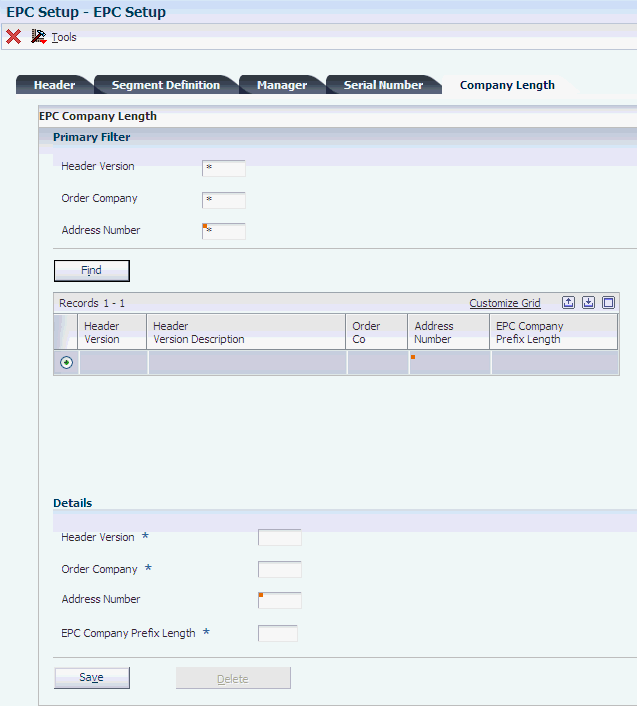
Description of ''Figure 4-6 EPC Setup form — Company Length tab''
- Order Company
-
A number that, along with order number and order type, uniquely identifies an order document (such as a purchase order, a contract, a sales order, and so on).
- Address Number (Optional)
-
A number that identifies an entry in the JD Edwards EnterpriseOne Address Book system, such as customer.
- EPC Company Prefix Length
-
The decimal length of the EPCglobal assigned Company Prefix
4.6.4 Setting Up EPC Partition Definition
Access the EPC Setup form, Header tab, and then select EPC Partition Definition. This is only required when setting up GTIN or SSCC
Figure 4-7 Search for EPC Partition Definition form
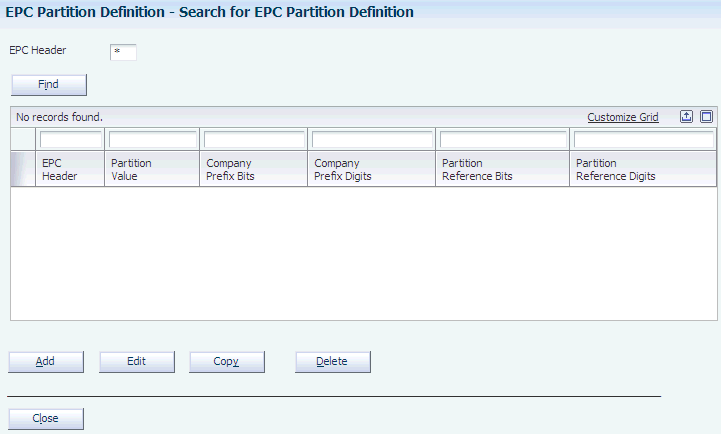
Description of ''Figure 4-7 Search for EPC Partition Definition form''
- Partition value
-
An indicator value of where the Company Prefix is divided from the corresponding reference value.
- Company prefix bits
-
The number of bits representing the Company Prefix.
- Company prefix digits
-
The decimal length of the EPCglobal assigned Company Prefix.
- Partition reference bits
-
The number of bits representing the reference value corresponding to the identity type for the EPC number. For example, the item reference for SGTIN-96 or the serial reference for SSCC-96.
- Partition reference digits
-
The decimal length representing the reference value corresponding to the identity type for the EPC number. For example, the item reference for SGTIN-96 or the serial reference for SSCC-96.
4.6.5 Generating EPC Numbers When Creating Carton Detail
Access the Carton Detail Add/Update form.
Figure 4-8 Carton Detail Add/Update form

Description of ''Figure 4-8 Carton Detail Add/Update form''
- Type in an EPC
-
Select this option to manually enter an EPC value to apply to this carton.
- Generate EPC
-
Click Generate EPC to automatically generate the EPC and apply it to this carton.
